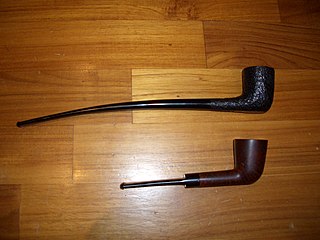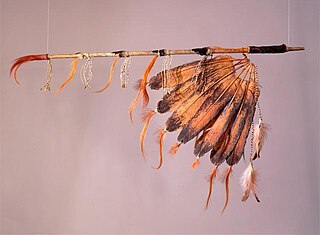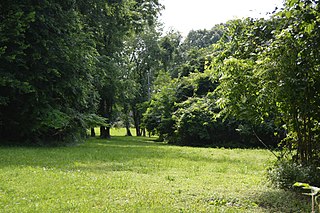
A tobacco pipe, often called simply a pipe, is a device specifically made to smoke tobacco. It comprises a chamber for the tobacco from which a thin hollow stem (shank) emerges, ending in a mouthpiece. Pipes can range from very simple machine-made briar models to highly prized hand-made artisanal implements made by renowned pipemakers, which are often very expensive collector's items. Pipe smoking is the oldest known traditional form of tobacco smoking.

A bong is a filtration device generally used for smoking cannabis, tobacco, or other herbal substances. In the bong shown in the photo, the smoke flows from the lower port on the left to the upper port on the right.

A churchwarden pipe is a tobacco pipe with a long stem. The history of the pipe style is traced to the late eighteenth or early nineteenth century. Some churchwarden pipes can be as long as 16 inches (40 cm). In German the style is referred to as "Lesepfeife" or "reading pipe", presumably because the longer stem allowed an unimpeded view of one's book, and smoke does not form near the reader's eyes, allowing one to look down.

The Great Serpent Mound is a 1,348-feet-long (411 m), three-feet-high prehistoric effigy mound located in Peebles, Ohio. It was built on what is known as the Serpent Mound crater plateau, running along the Ohio Brush Creek in Adams County, Ohio. The mound is the largest serpent effigy known in the world.

Catlinite, also called pipestone, is a type of argillite, usually brownish-red in color, which occurs in a matrix of Sioux Quartzite. Because it is fine-grained and easily worked, it is prized by Native Americans, primarily those of the Plains nations, for use in making ceremonial pipes, known as chanunpas or čhaŋnúŋpas in the Lakota language. Pipestone quarries are located and preserved in Pipestone National Monument outside Pipestone, Minnesota, in Pipestone County, Minnesota, and at the Pipestone River in Ontario, Canada.

A meerschaum pipe is a smoking pipe made from the mineral sepiolite, also known as meerschaum. Meerschaum is sometimes found floating on the Black Sea and is rather suggestive of sea foam.

Pipe smoking is the practice of tasting the smoke produced by burning a substance, most commonly tobacco and cannabis, in a pipe. It is the oldest traditional form of smoking.

Cannabis smoking is the inhalation of smoke or vapor released by heating the flowers, leaves, or extracts of cannabis and releasing the main psychoactive chemical, Δ9-tetrahydrocannabinol (THC), which is absorbed into the bloodstream via the lungs. Archaeological evidence indicates cannabis with high levels of THC was being smoked at least 2,500 years ago. As of 2021, cannabis is the most commonly consumed federally illegal drug in the United States, with 36.4 million people consuming it monthly.

A bowl, when referred to in pipe smoking, is the part of a smoking pipe or bong that is used to hold tobacco, cannabis, or other substances.
Post-excavation analysis constitutes processes that are used to study archaeological materials after an excavation is completed. Since the advent of "New Archaeology" in the 1960s, the use of scientific techniques in archaeology has grown in importance. This trend is directly reflected in the increasing application of the scientific method to post-excavation analysis. The first step in post-excavation analysis should be to determine what one is trying to find out and what techniques can be used to provide answers. Techniques chosen will ultimately depend on what type of artifact(s) one wishes to study. This article outlines processes for analyzing different artifact classes and describes popular techniques used to analyze each class of artifact. Keep in mind that archaeologists frequently alter or add techniques in the process of analysis as observations can alter original research questions.

A smoking pipe is used to taste the smoke of a burning substance; most common is a tobacco pipe. Pipes are commonly made from briar, heather, corn, meerschaum, clay, cherry, glass, porcelain, ebonite and acrylic.
Chesapeake pipes, which are also known as colono-pipes, terra-cotta pipes, local pipes, Virginia-made pipes and aboriginal pipes, refer to a type of tobacco pipe that was produced in the Chesapeake Bay region of eastern North America during the 17th century. Made out of local clays, the pipes had a distinctive orange or brown color, with many being decorated with abstract designs and motifs. Such pipes are so common that they have been described as being "ubiquitous in [the] archaeological sites of Virginia and Maryland".

A ceremonial pipe is a particular type of smoking pipe, used by a number of cultures of the indigenous peoples of the Americas in their sacred ceremonies. Traditionally they are used to offer prayers in a religious ceremony, to make a ceremonial commitment, or to seal a covenant or treaty. The pipe ceremony may be a component of a larger ceremony, or held as a sacred ceremony in and of itself. Indigenous peoples of the Americas who use ceremonial pipes have names for them in each culture's Indigenous language. Not all cultures have pipe traditions, and there is no single word for all ceremonial pipes across the hundreds of diverse Native American languages.

Potomac Creek, or 44ST2, is a late Native American village located on the Potomac River in Stafford County, Virginia. It is from the Woodland Period and dates from 1300 to 1550. There is another Potomac Creek site, 44ST1 or Indian Point, which was occupied by the Patawomeck during the historic period and is where Captain John Smith visited. This site no longer exists, as it eroded away into the river. Site 44ST2 has five ossuaries, one individual burial, and one multiple burial. Other names for the site are Potowemeke and Patawomeke. The defining features include distinctive ceramics, ossuary burials, and palisade villages.

The Amsterdam Pipe Museum is a museum in Amsterdam, the Netherlands, dedicated to smoking pipes, tobacco, and related paraphernalia. It holds the national reference collection in these areas.
Chronological dating, or simply dating, is the process of attributing to an object or event a date in the past, allowing such object or event to be located in a previously established chronology. This usually requires what is commonly known as a "dating method". Several dating methods exist, depending on different criteria and techniques, and some very well known examples of disciplines using such techniques are, for example, history, archaeology, geology, paleontology, astronomy and even forensic science, since in the latter it is sometimes necessary to investigate the moment in the past during which the death of a cadaver occurred. These methods are typically identified as absolute, which involves a specified date or date range, or relative, which refers to dating which places artifacts or events on a timeline relative to other events and/or artifacts. Other markers can help place an artifact or event in a chronology, such as nearby writings and stratigraphic markers.
Jean Carl Harrington was an American archaeologist best known for his work at Jamestown, Virginia and his contributions to the methodology of historical archaeology. He has been called the "father of historical archaeology in America".

White pipe clay is a white-firing clay of the sort that is used to make tobacco smoking pipes, which tended to be treated as disposable objects. This suited pipeclay, which is not very strong.
Eduard Bird was an English tobacco pipe maker who spent most of his life in Amsterdam. His life has been reconstructed by analysis of public registers, probate records, and notary and police records, by historians such as Don Duco and Margriet De Roever from the 1970s onwards. Pipes with the "EB" stamp have been found around the world.

The Upper Iowa River Oneota site complex is a series of 7 Iowa archaeological sites located within a few miles of each other in Allamakee County, Iowa, on or near the Upper Iowa River. They are all affiliated with the Late Prehistoric Upper Mississippian Oneota Orr focus. In some cases there are early European trade goods present, indicating occupation continued into the Protohistoric or early Historic period.
















